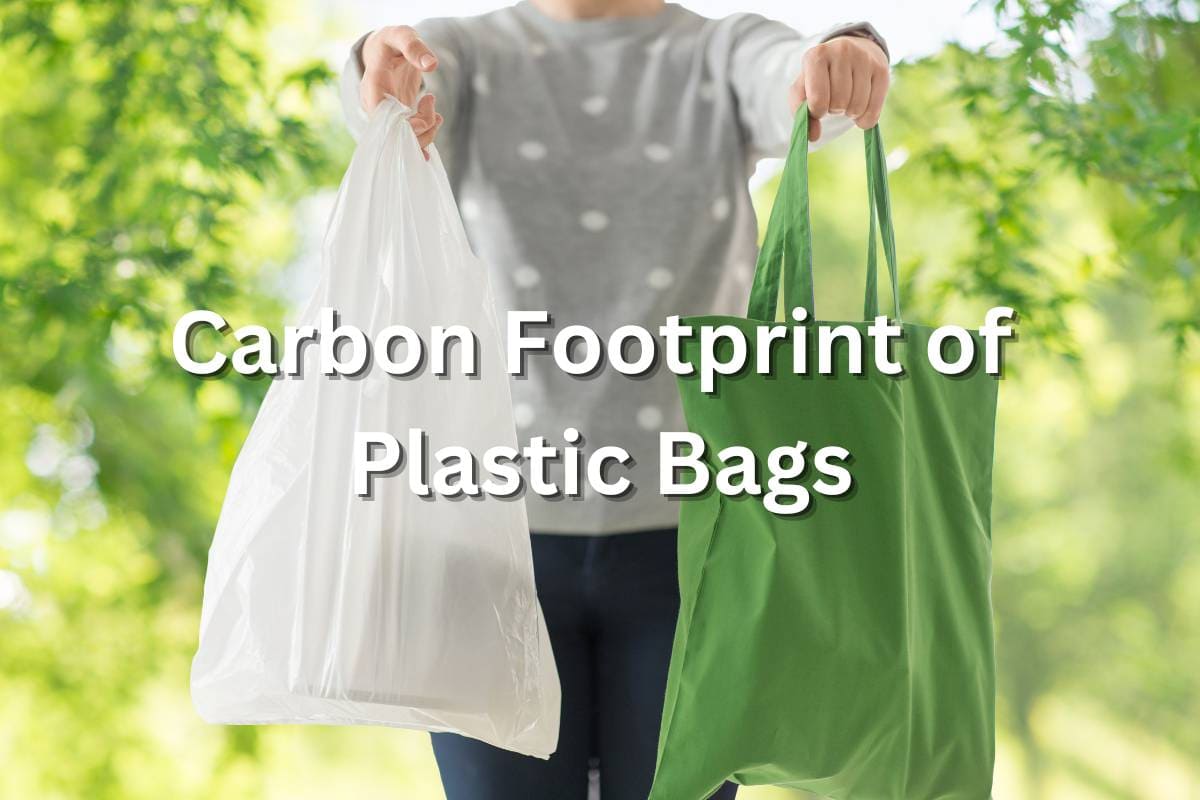The carbon footprint of a plastic bag involves all stages of its lifecycle, from production to disposal. On average, a standard plastic bag has a carbon footprint of about 1.58 kg of CO2 equivalent per 1,000 bags used. This relatively low footprint is primarily due to the efficiency of plastic production compared to other materials like paper or cotton.
Factors Contributing to the Carbon Footprint of Plastic Bags
- Plastic Production:
The production of plastic bags starts with extracting and refining fossil fuels like petroleum. This process requires a lot of energy, leading to significant greenhouse gas emissions. At refineries, crude oil is cracked to produce ethylene and propylene, which are the main ingredients in plastic. These are then polymerized into polyethylene, the material most plastic bags are made from. Every step, from extraction to bag creation, adds to the carbon footprint because it relies heavily on fossil fuels. - Single-Use Nature:
Most plastic bags are designed for single use. After one use, they are usually discarded, adding to environmental waste. Globally, billions of plastic bags are produced and quickly thrown away each year. This results in large amounts of waste that persist in the environment. These bags don’t biodegrade; instead, they break down into microplastics, which pollute ecosystems and harm wildlife. - Recycling of Plastic:
Recycling plastic bags can reduce their environmental impact, but it’s not common. Less than 10% of plastic bags are recycled worldwide. Most end up in landfills, incinerators, or as litter. The correct statement should be that plastic bags take up space in landfills and persist for hundreds of years without biodegrading. Instead of decomposing, plastic bags break down into smaller and smaller pieces of plastic, known as microplastics, which can spread throughout the environment. When burned, they release CO2 and toxins. In the environment, they break down into microplastics, causing further harm. The low recycling rates mean that most plastic bags contribute to ongoing environmental pollution.
Interesting Facts
Plastic vs. Paper Bags
Plastic bags have a smaller carbon footprint during production compared to paper bags. Paper bags, although biodegradable, require more resources to produce and thus have a higher carbon footprint.
Reusable Bags
Reusable shopping bags, such as those made from cloth, have a much higher carbon footprint during production. However, if used frequently, they can become more eco-friendly over time. For example, a cotton tote needs to be used over 7,000 times to match the environmental impact of a plastic bag.
Plastic Bag Bans
Many regions are banning single-use plastic bags to reduce plastic waste. However, switching to alternatives like paper or cloth bags requires careful consideration of their own environmental impacts.
Tips to Reduce the Carbon Footprint of Plastic Bags
- Reuse Plastic Bags:
Reusing plastic shopping bags can significantly lower their overall carbon footprint. Reuse them as many times as possible before recycling them. - Opt for Reusable Bags:
Choose reusable bags made from durable materials and ensure you use them frequently. This can be a more sustainable option in the long run. - Reduce Plastic Usage:
Minimize the use of plastic bags by opting for alternatives like paper bags or eco-friendly materials, but keep in mind their overall environmental impacts.
Efforts in Reducing the Environmental Impact of Plastic Bags
Large-Scale Efforts to Reduce the Environmental Impact of Plastic Bags
Significant efforts are being made globally and within the U.S. to tackle the environmental impact of plastic bags. These initiatives are driven by government policies, corporate commitments, and international collaborations.
1. National Strategies and Policies:
The Biden-Harris Administration has taken a strong stance against plastic pollution by introducing the “National Strategy to Prevent Plastic Pollution.” This strategy aims to reduce plastic waste from production to disposal. The plan includes reducing single-use plastic products, improving waste management, and promoting recycling. The ultimate goal is to prevent plastic from entering the environment and contributing to pollution by 2040 (US EPA) (Jenner & Block).
2. Plastic Bag Bans:
Across the U.S., states and cities have implemented bans on single-use plastic bags. These bans have led to a massive reduction in plastic bag usage. For instance, plastic bag bans in places like New Jersey and Vermont have reduced the use of billions of plastic bags annually. These measures not only reduce plastic waste but also encourage the adoption of reusable bags (World Economic Forum) (publicinterestnetwork).
3. Private Sector Initiatives:
Private companies and financial institutions are also playing a crucial role. The World Bank, for example, is channeling private capital into projects that reduce plastic waste. They have developed innovative financial tools, such as outcome bonds, to fund plastic collection and recycling projects. These efforts aim to reduce plastic pollution, particularly in developing countries, where the impact is most severe (World Bank).
4. International Agreements:
The U.S. and other nations are part of global initiatives to combat plastic pollution. In 2022, about 175 countries agreed to work on an internationally binding agreement to end plastic pollution by 2024. This agreement seeks to enforce global standards for plastic production, use, and disposal, aiming to significantly reduce the global plastic footprint (Jenner & Block).
These combined efforts demonstrate a robust approach to tackling the plastic pollution crisis. By integrating governmental policies, corporate responsibility, and international cooperation, there is a collective push towards reducing the environmental impact of plastic bags and other plastic products.
Conclusion
While plastic bags have a relatively low carbon footprint during production, their environmental impact is significant due to waste and pollution. Alternatives like reusable shopping bags can reduce this impact, but they require careful consideration and frequent use to be truly effective. Reducing plastic usage and supporting recycling initiatives are key strategies in minimizing the environmental impact.
Other Sources Used
- Plastic’s Carbon Footprint | The Current
- Carbon Footprint Factsheet | Center for Sustainable Systems
- Would stopping plastic pollution help with climate change? | MIT Climate Portal
- Plastic, Paper or Cotton: Which Shopping Bag is Best? | Columbia Climate School
- COMET: Making Plastics Emissions Transparent | Columbia Center on Sustainable Investment




